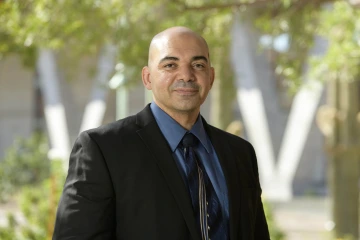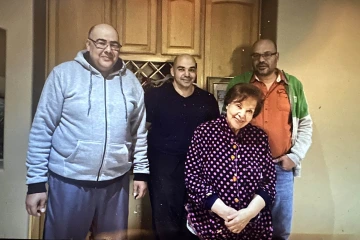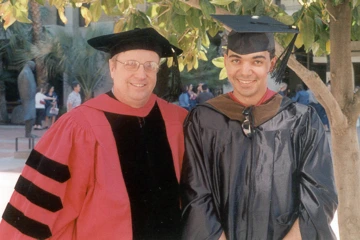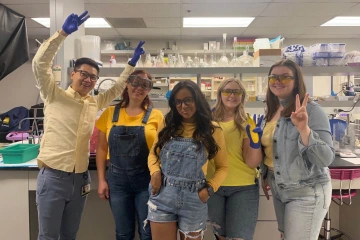Physician-Scientist Finds Purpose in a Life Devoted to Pain
Dr. Mohab Ibrahim always knew he wanted to be a doctor; his lived experience and mentors helped him find his calling as a pain specialist and researcher.

(From left) Assistant research professor Laurent Martin, PhD, and Mohab Ibrahim, MD, PhD, check the intensity of green light in a laboratory. In clinical trials. Dr. Ibrahim has shown the value of using of green light therapy for chronic pain resulting from migraine and fibromyalgia.
The woman’s anguished screams filled the small van. Her traveling companions – strangers united by fate – had nothing to offer but compassion as she gripped her abdomen in a futile attempt to stop the pain of cancer destroying her body. Before, there were medications, but not now. Prescriptions went unfilled as hospitals closed during the Iraqi invasion of Kuwait.
A 16-year-old boy watched silently as their clandestine journey took them through Iraq to Jordan, where they would board a plane for Egypt, the boy’s native land. But the woman didn’t make it that far. Officials at the Jordan border took her body as the van, now silent, continued.

“I didn't want to just study what other people discovered. I wanted to contribute to the discovery process,” Mohab Ibrahim, MD, PhD, said of his decision to pursue a career in research, as well as medicine.
“Her pain became so severe that she was begging to die, and all we were able to do was hold her hands. It certainly affected me, and I decided that day – or at least it became part of my psyche – that pain needs to be better controlled,” Mohab Ibrahim, MD, PhD, recalled. “That experience really shaped me and made me want to understand pain better and find ways to manage it.”
Thirty years later, Ibrahim remains true to his calling as a physician-scientist at the University of Arizona Health Sciences.
As a clinician, he sees patients two days a week at the Banner – University Medicine Chronic Pain Clinic, where he also serves as the director. The rest of the week, he steps into researcher and administrator roles as the associate medical director of the U of A Health Sciences Comprehensive Center for Pain & Addiction and a professor of anesthesiology at the College of Medicine – Tucson.
Born to be a healer
Long before Ibrahim left Kuwait, he knew he wanted to be a doctor. He fondly remembers following his father, an orthopedic surgeon and internal medicine specialist, around the hospital as a young boy. His mother was a nurse, and she fostered her youngest son’s interest in medicine by making sure his toys included things like doctor kits.

Dr. Mohab Ibrahim (middle) credits his mother, Reem Ismail (front) for much of his success. The close-knit family includes his two brothers, Amal Ibrahim (left) and Wael Ibrahim (right), who are both engineers.
“I honestly saw myself as a physician,” said Ibrahim, whose brothers are all engineers. “I didn't consider any other career.”
He never swayed from that childhood dream. After graduating from high school in Egypt, he enrolled at the University of Cairo for one year while he made plans to come to the U.S. to study medicine. In Cairo, rather than study physiology or biology, like other medical school hopefuls, he went into the unlikely field of geophysics.
“I figured I was going to spend the rest of my life doing medicine, so I wanted to study something that had nothing to do with medicine or biology. I just wanted something fun,” Ibrahim said. “The funny thing is the things that scared me the most in Egypt – physics and mathematics – I really liked them here to the point where my undergraduate degree was in biochemistry with a minor in mathematics.”
Ibrahim’s love of learning can be attributed to the influence of his mother, Reem Ismail, who in addition to being a nurse, is a writer, poet and artist.
“My mom is in a league of her own for the things she has done to support me and encourage me,” Ibrahim said of his mother, who now spends her time in Tucson, Arizona, painting, crocheting, knitting and doing other forms of art for fun. “What she did is heroic. I cannot give her enough credit for how much she supported me.”
In perhaps another nod to his mother’s influence, when he arrived in the U.S., Ibrahim’s first job was as an art gallery assistant at Pima Community College. A month later, he walked into his first undergraduate course at the University of Arizona.
Embarking on a journey of discovery

Dr. Ibrahim was an undergraduate when he met Phil Malan, MD, PhD, who became an important mentor and life-long friend.
It was as an undergraduate that Ibrahim was introduced to concept of academic research. He joined the biochemistry and entomology lab of Regents Professor John Law, PhD, where he was mentored by Rolf Ziegler, PhD. He watched and learned from other students in the lab, inheriting his first research projects when they graduated and moved on.
Ibrahim might have stayed in the same lab throughout his undergraduate years, but Law retired and Ziegler returned to Germany. After applying and being accepted to the University of Arizona’s Undergraduate Biology Research Program, Ibrahim went on the hunt for a new mentor. This time, as he read through the UBRP’s list of researchers and projects, he focused on those studying pain.
“Keep in mind, I was maybe a sophomore or junior at that time, so many of the scientific language, jargon and concepts just flew over my head,” said Ibrahim, whose first language is Arabic. “So I'm reading descriptions about the different research labs, and I have no idea what they’re talking about – until I found a couple of people that were doing something related to pain.
“Dr. Phil Malan was one of them, and the description was very simple. I still remember it. It was just two lines that said, ‘This lab is interested in understanding the biology of pain and finding new methods to control it.’”

One of Dr. Ibrahim’s patients came to him with one goal: to be able to play with her kids. After treating her chronic pain, Dr. Ibrahim was presented with this heart-felt thank you note from one of the woman’s children. He was so moved he framed the note, which is now displayed in his house.
From their initial meeting, when anesthesiologist Phil Malan, MD, PhD, ran into the room apologizing for being late after stabilizing a patient in the operating room, the two men formed an instant bond. As Ibrahim’s research skills grew, Malan began asking his pupil what he wanted to do when he graduated. Ibrahim’s answer was simple and unwavering: “I’m interested in pain, and I want to be a physician to manage it.”
Ibrahim’s undergraduate years were ending when Malan suggested he consider graduate school to further his research before applying to medical school. Ibrahim took the advice and committed to a master’s program. When the end of that program drew near, Malan suggested he consider getting a doctorate in pharmacology and toxicology before pursuing a medical degree.
“I wanted to follow in his footsteps, and clearly he was listening,” said Ibrahim, who finished his doctorate at the University of Arizona before being accepted to medical school.
Malan supported Ibrahim through his doctoral work, into medical school, when he continued to study under Malan as a postdoctoral researcher, and beyond. He attended every one of Ibrahim’s graduation ceremonies, from undergraduate to residency.
“He is like a father to me,” said Ibrahim, who lost his own father when he was 8. “Phil certainly helped shape the person that I am today. I was lucky to have him as a mentor who really helped channel my passion and my energy into the science I'm doing today.”
The two men remain close friends to this day.
Living with intention
Today, Ibrahim is living the life he imagined for himself as a child. He helps people manage pain as a board-certified anesthesiologist with a subspecialty certification in pain management. He is also an internationally recognized pain researcher for his work on green light therapy for chronic pain including migraine and fibromyalgia.

Dr. Ibrahim says the undergraduate and graduate students in his lab play an integral role in the success of his research. (From left) Kevin Chang, Stephanie Washington, Hannah Korah, Millie Denton and Kyleigh Masterson.
“One feeds the other,” Ibrahim said when asked if he preferred medicine or research. “I designed my research to answer questions I'm struggling with in the clinic. So if I have a situation where it’s challenging to manage a condition, that's what I ended up researching in the lab to come up with solutions. That's one of the ways we came up with green light, because it was very hard to manage fibromyalgia.”
His research has found green light to be a viable complement to opioids for the management of chronic pain in some people. On average, participants in clinical trials for migraine and fibromyalgia noted a reduction in pain, with around 60% of chronic migraine patients reporting fewer headache days per month thanks to green light therapy.
Ibrahim continues to search for answers in the lab and in the clinic guided by his mentors, Malan, and professors Frank Porreca, PhD, and Todd Vanderah, PhD, of the Comprehensive Center for Pain & Addiction and College of Medicine – Tucson’s Department of Pharmacology. In both locations, Ibrahim’s passion for helping people is evident.

“I am fortunate to be in a position to bridge basic science with clinical science and collaborate with both scientists and physicians,” said Dr. Ibrahim, pictured with professor Todd Vanderah, PhD, director of the Comprehensive Pain and Addiction Center and head of the Department of Pharmacology.
His soft-spoken nature is balanced by a sense of humor that shines through when he walks into a patient’s room wearing a Pink Panther t-shirt emblazoned with the words, “One cool cat.” His dedication to helping others is seen in the way he works, whether spending years battling insurance companies to finance a treatment he knows will most likely help a patient or taking a few minutes to talk to someone who attends one of his lectures about the benefits of green light therapy.
His patients respond to his compassionate manner, leaving multiple five-star reviews with comments including: “Dr. Ibrahim cares about his patients and does whatever he can to make his patients comfortable and accommodate their needs,” and “Dr. Ibrahim was always a joy to have as a doctor. He was patient, kind, funny and such an amazing person.”
At the end of the day, Ibrahim is fulfilling his purpose while following his passion to help people manage their pain so that they, like him, can live their best lives.
Our Experts
Mohab Ibrahim, MD, PhD
Professor of Anesthesiology
Contact
Stacy Pigott
Health Sciences Office of Communications
520-539-4152
spigott@arizona.edu

